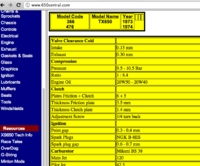OakBehringer
XS650 Guru
Intake/Exhaust
MikesXS and 650Central: .006 / .012
Various posts on this form: .003 / .006
My Clymer: (don't remember, I think it lists the same for both, though!)
Other sites on the Internet: a myriad of different values
I just noticed these varying specs. Anyone have the correct answer with a reliable reason? I'm inclined to go with .006/.012 to be safe.
MikesXS and 650Central: .006 / .012
Various posts on this form: .003 / .006
My Clymer: (don't remember, I think it lists the same for both, though!)
Other sites on the Internet: a myriad of different values
I just noticed these varying specs. Anyone have the correct answer with a reliable reason? I'm inclined to go with .006/.012 to be safe.


